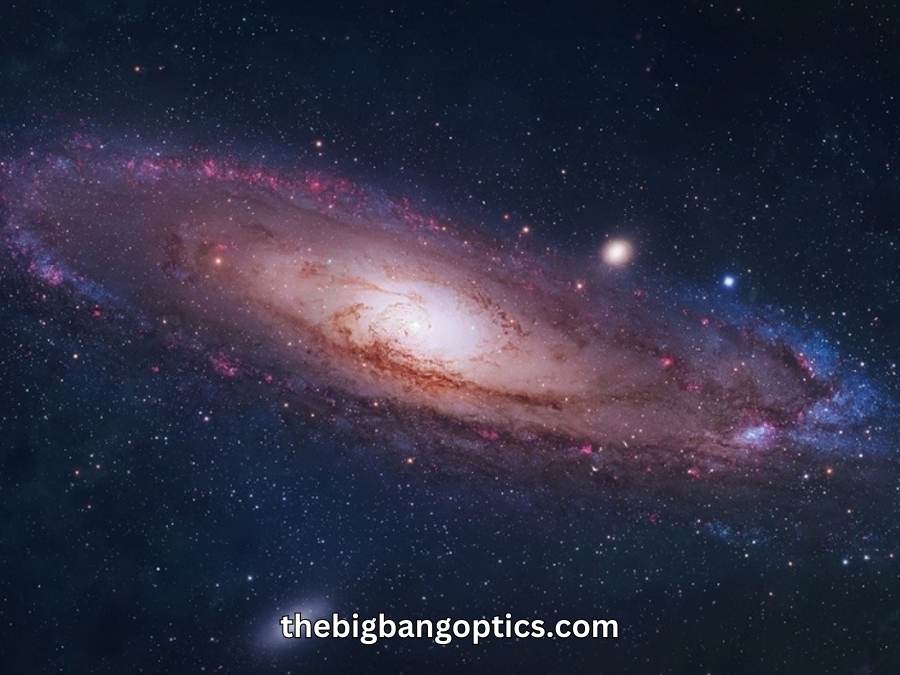How Many Planets Are in The Andromeda Galaxy?

The universe is a vast expanse, filled with galaxies beyond imagination. Among these cosmic wonders, the Andromeda Galaxy stands out as a captivating neighbor to our own Milky Way. Its spiral arms stretch across the void, containing an unimaginable number of stars, and with them, the potential for countless planets.
In this article, we delve into the story of the planets that may call the Andromeda Galaxy their home, while unraveling the methods used to estimate their abundance and their significance in expanding our understanding of the universe.
How Many Planets Are in The Andromeda Galaxy?
At the moment, we only have information about a single potential planet known as PA-99-N2. However, it is important to note that this object has not yet been confirmed as a planet. Its existence came to light during the microlensing event of 1999, but further analysis is needed to determine its true nature.
The PA-99-N2
PA-99-N2 has intrigued astronomers since its discovery over two decades ago. Although it has not been officially classified as a planet, scientists have made estimates regarding its characteristics.
According to their findings from 2007, this mysterious object may possess a mass six to seven times that of Jupiter. Such a massive size would make it an impressive addition to the planetary family within Andromeda.
While these estimates offer some insights into PA-99-N2’s potential properties, they also highlight how much more we have yet to learn about the planets in Andromeda.
As our understanding and technology continue to advance, we can expect future discoveries that will shed light on this fascinating galaxy’s planetary system.

Andromeda Galaxy Planets Details
Currently, there is only one known planet in the Andromeda galaxy, known as PA-99-N2. At this time, there is not a comprehensive list of planets available. Here are some details about PA-99-N2.
| Constellation | Andromeda |
| Mass | 6.34 times the Mass of Jupiter |
| Declination | +41° 28′ 44.6″ |
| Distance | 2,185,247.73 Ly |
| Right ascension | 00h 44m 20.89 |
The Pan Event and Exoplanets in Andromeda
The Pan Event, a groundbreaking discovery by astronomers, shed light on the existence of exoplanets within the vast expanse of the Andromeda Galaxy.
During the Pan Event, telescopes including the Hubble Space Telescope were focused on observing a microlensing event in Andromeda.
This phenomenon occurs when a massive object, such as a black hole or a star, passes in front of another object, causing its gravitational field to bend and magnify the light from more distant sources.
By carefully studying these microlensing events, astronomers were able to identify multiple exoplanetary systems within Andromeda.
Studying these exoplanets provides valuable insights into their formation and characteristics. It allows us to compare them with our own solar system and understand how planetary systems can vary across different regions of the universe.
Can Andromeda Galaxy Planets Support Life?
In order for a planet to sustain human life, certain conditions need to be met. One crucial factor is being located within what scientists refer to as the “Goldilocks zone” or the habitable zone.
This region around a star provides just the right amount of warmth for liquid water to exist on a planet’s surface. Without water, life as we know it cannot thrive.
Within this Goldilocks zone, a planet can possess earth-like conditions necessary for supporting life. It requires not only an adequate temperature range but also an atmosphere capable of retaining heat and providing protection from harmful radiation.
These factors contribute significantly towards creating an environment suitable for sustaining living organisms.
An atmosphere composed primarily of nitrogen (N2) and oxygen (O2), like Earth’s, allows for respiration and provides protection from harmful solar radiation.
Trace amounts of other gases, such as carbon dioxide (CO2) and hydrogen (H2), contribute to the overall composition. These elements are essential for maintaining a stable climate and facilitating various biological processes.
Andromeda Galaxy Planets Pictures
As of now, there are no pictures available of the planets in this galaxy. But don’t fret! Scientists and astronomers have other ways to study and understand these distant celestial bodies.
While we may not have actual photographs, there is always an artistic depiction of the planet that can be drawn based on the information gathered.
Through careful observation and analysis, scientists can make predictions about how these planets might look by studying the light we collect from them.
RELATED: Can Telescopes See Stars And Planets In Other Galaxies

How many stars are there in the Andromeda Galaxy?
The Andromeda Galaxy, also known as Messier 31 or M31, is estimated to contain around 1 trillion stars. This makes it the largest galaxy in the Local Group, which is the group of galaxies that includes our own Milky Way galaxy.
Keep in mind that this is an estimate, and the exact number of stars in galaxies can be challenging to determine precisely.
Within this colossal collection of stars lie numerous variable stars – those whose brightness fluctuates over time. These variable stars can provide valuable insights into exoplanet research.
By studying these fluctuations and observing any patterns or irregularities, scientists can gain crucial information about potential exoplanets orbiting these distant suns.
How Many Solar Systems are there in the Andromeda Galaxy?
With over a trillion stars in Andromeda galaxy, it’s almost certain that many of them possess sun-like features, making it highly likely that they also host their own planets.
While we can’t say with absolute certainty how many solar systems exist in the Andromeda galaxy, it’s safe to assume that there must be an abundance of them. Our current technology and understanding of the universe only allow us to scratch the surface.
However, as our scientific capabilities continue to advance, we can expect new discoveries that will shed light on the number of solar systems present in this cosmic wonderland.
By using various techniques such as transit observations and gravitational microlensing, researchers have been able to detect exoplanets located thousands or even millions of light-years away from Earth.
Formation and History of Andromeda Galaxy
The formation of the Andromeda Galaxy is believed to have occurred around 10 billion years ago. Scientists theorize that it originated from the collapse of a giant molecular cloud composed primarily of hydrogen gas.
As gravity took hold, the cloud began to condense and form stars, eventually giving birth to this magnificent galaxy.
During its early stages, the Andromeda Galaxy experienced rapid star formation. The abundance of gas and dust in its vicinity provided fertile ground for stellar nurseries to flourish.
Throughout its history, the Andromeda Galaxy engaged in numerous interactions with smaller galaxies through gravitational forces. These interactions often led to mergers between galaxies, resulting in significant changes to their structures.
One notable merger event was with a dwarf galaxy called M32. This collision caused M32 to become a satellite galaxy orbiting around Andromeda.
Such mergers not only altered the shape and size of both galaxies but also played a crucial role in redistributing matter within them.
Another major interaction involved Messier 110 (M110), another dwarf galaxy that became gravitationally bound to Andromeda due to their close encounter.
This interaction resulted in tidal forces stripping away some material from M110 while leaving behind visible streams of stars surrounding both galaxies.

Collision Course: Milky Way meets Andromeda
The Milky Way and the Andromeda Galaxy are on a collision course, set to merge in about 4 billion years.
These two galactic behemoths are hurtling towards each other at an astonishing speed. In approximately 4 billion years, their paths will intersect, resulting in a spectacular collision that will forever alter the face of our night sky.
As they draw closer to one another, the gravitational forces between these colossal entities become increasingly influential. Over time, this gravitational dance will bring them together until they eventually merge into a single entity.
The immense gravitational forces generated by this cosmic encounter can send planets hurtling off on entirely new trajectories. Some may be captured by their newfound host galaxy while others might be cast adrift through intergalactic space, forever severed from their original home.
Final Words
In conclusion, it’s really difficult to gather accurate information about the planets in the Andromeda Galaxy because it is located over 2.5 million light years away. However, there is one potential planet that has been detected, but it still needs to be confirmed. Although astronomers haven’t been able to prove the existence of specific planets in the galaxy, it is highly likely that there are millions or even billions of planets in Andromeda that are just waiting to be discovered.
Frequently Asked Questions (FAQs)
1. How do astronomers estimate the number of planets in the Andromeda Galaxy?
Astronomers use various methods, such as observing star systems and analyzing the distribution of stars and their likelihood of hosting planets. They also make use of data from exoplanet discoveries in our own galaxy to extrapolate the potential number of planets in Andromeda.
2. Are the planets in the Andromeda Galaxy similar to those in our Milky Way?
It’s plausible that the Andromeda Galaxy could have planets with diverse characteristics, including rocky planets, gas giants, and potentially habitable worlds. However, without direct observation, it’s challenging to determine the specifics of their compositions.
3. Could the Andromeda Galaxy have Earth-like planets?
Yes, it’s possible. Given the vast number of stars and planets in the galaxy, there’s a chance that Andromeda hosts planets with conditions similar to Earth. Discovering such planets would require advanced observational techniques.
4. How might the study of exoplanets in the Andromeda Galaxy contribute to our understanding of the universe?
Studying exoplanets in Andromeda can help astronomers refine models of planet formation and evolution. It can also offer insights into the prevalence of different types of planets and their potential habitability, advancing our understanding of planetary systems on a larger scale.
Written by:

Kavya Joshi
My love affair with space began in a field in India at the age of 7, when I looked up at the Milky Way for the first time. Ever since, I have been attempting to cram in every fact about the Universe, I can find into my head.
ABOUT US
We are a team of active amateur astronomers, here to help you with all your astronomy and science related needs – this is anything, from reviewing the latest telescopes to be released to talking about gravity and neurons. The Big Bang Optics was started because of our love for astronomy and to help others like us find the best telescope and accessories.
LEGAL DISCLAIMER
The Big Bang Optics is a participant in the Amazon Services LLC Associates Program, an affiliate advertising program designed to provide a means for sites to earn advertising fees by advertising and linking to Amazon.com. The Big Bang Optics also participates in affiliate programs with Clickbank and other sites. The Big Bang Optics is compensated for referring traffic and business to these companies.




